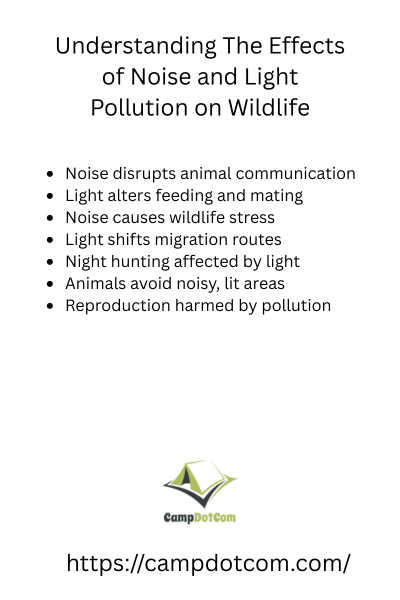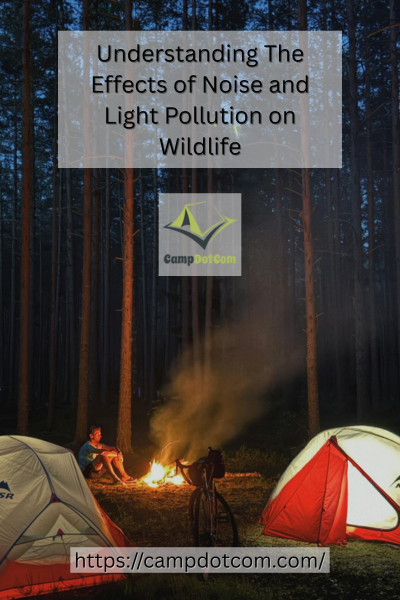Understanding the effects of noise and light pollution on wildlife is not just for scientists or environmental activists. It is for anyone who loves the outdoors, enjoys a quiet night sky, or cares about the amazing creatures we share this planet with.
I first started thinking about this when I went camping in the mountains a few years ago. We were miles from the nearest town, and at night, the stars were unbelievably bright. No hum of traffic, no glow from streetlights, just pure silence and darkness. In that moment, I realized how rare that is for most animals, and for us too. Back home, the constant buzz of cars and glow from nearby stores made me wonder how much all this actually affects wildlife. Turns out, quite a lot.
Read More About Understanding The Effects of Noise and Light Pollution on Wildlife

Why Noise Pollution Messes With Nature
When we talk about noise pollution, it is not just about loud things like blasting music or construction sounds. For animals, even soft and steady noises can cause problems—like the hum of highways, boats moving across lakes, or planes flying overhead.
As an Amazon Associate, I earn from qualifying purchases. Some of the links in this article are affiliate links. This means that, at zero cost to you, I will earn an affiliate commission if you click through the link and finalize a purchase.
Many animals rely on sounds to live their lives. Birds sing to find a mate and warn others about danger. Frogs croak to mark their space. Bats use sound to hunt in the dark. Now imagine trying to do all that while someone nearby is running a noisy leaf blower. It would be pretty tiring, right?
The tricky part is that some animals cannot just shout louder. Their calls are made for their special surroundings. When human noise covers their sounds, they might miss finding a mate, miss important warnings, or lose track of food. Over time, this can lead to fewer animals around and they do not have a way to ask for help.
More Things to Know About Understanding The Effects of Noise and Light Pollution on Wildlife

Light Pollution: When Nights Aren’t Really Night
Light pollution is sneakier than noise, but it’s just as disruptive. Bright streetlights, billboards, stadium lights, and even porch lights can mess with wildlife in surprising ways.
Take sea turtles, for example. Hatchlings find the ocean by moving toward the brightest horizon, which used to be moonlight reflecting off the water. Now, they often head inland toward city lights—straight into danger.
Or consider birds that migrate at night. They use stars to navigate, but artificial light can confuse them, making them circle lit-up buildings until they’re exhausted. Some even collide with windows. It’s heartbreaking to think about, especially when a simple change like turning off unnecessary lights could help.
My “Oh No” Moment
One night, I left my backyard light on all evening. Seemed harmless, right? The next morning, I found dozens of moths stuck to the siding, some tired and even dead from exhaustion. It made me feel really bad. That moment showed me that light pollution is not just a problem in big cities—it can happen anywhere, even right in your own backyard.
After that, I started making small changes. I switched my bright white bulb to a warm, shielded one and set it on a timer. Now the light only comes on when it really needs to, and I get to enjoy lots more fireflies during the summer.
What You Can Do (It’s Easier Than You Think)
The good news? You don’t have to move to the middle of nowhere to make a difference. If you care about understanding the effects of noise and light pollution on wildlife, here are a few easy steps you can try:
Go dim and warm
Choose warm-colored LED bulbs (around 2700K) instead of bright, blue-white ones. The softer light is gentler on wildlife, helping to preserve their natural behaviors, and it also supports your body’s natural sleep rhythm by reducing blue light exposure before bedtime.
Shield your lights
Use fixtures or covers that direct light downward, focusing illumination only where it’s needed. This prevents light pollution, helps protect nocturnal wildlife, and keeps the night sky beautifully visible for stargazing.
Switch it off
When you’re not using a light, simply turn it off. Installing motion sensors or timers ensures lights only come on when necessary, saving energy and reducing constant artificial brightness in your surroundings.
Quiet your corner
Keep nighttime noise to a minimum by avoiding loud conversations, music, or machinery in outdoor spaces. Excessive noise can disrupt wildlife communication, stress animals, and disturb your neighbors’ rest.
Spread the word
Encourage your friends, neighbors, and even local officials to adopt light- and noise-friendly habits. Hosting a small community talk or sharing tips online can spark positive changes that benefit both nature and people.
Small actions add up, and your backyard could become a little oasis for wildlife.
Why This Matters
You might be thinking, “Okay, but is it really that big a deal?” Yes—it’s huge. Noise and light pollution don’t just bother animals; they can disrupt entire ecosystems. When one species struggles, others that depend on it can be affected too.
Plus, there’s a selfish bonus: reducing light and noise helps us sleep better, feel calmer, and enjoy nature more. You can stargaze without glare and actually hear crickets instead of cars. Win-win.
Why Every Quiet Moment and Dark Sky Matters to Wildlife
Understanding how noise and light pollution affect wildlife is about more than just protecting animals. It is about helping bring balance back to the world we share. Every light you turn off when it is not needed and every sound you keep down gives animals a better chance to live and thrive.
So next time you are outside after dark, take a moment to listen carefully and look up at the sky. Notice the stars, the quiet sounds, and all the life around you. If we can keep that safe and peaceful, well, that is definitely something worth talking about, don’t you think?
